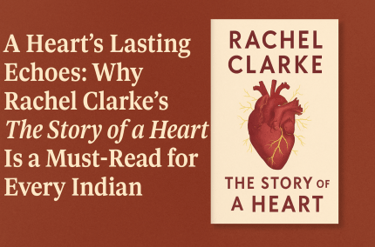Rachel Clarke's Story of a Heart: A Must-Read
BOOKS REVIEW
Chaifry
7/1/20257 min read


This book is a must-read for every Indian—students, teachers, parents, and everyday folks—because it speaks to the core of who we are: a people who value compassion, community, and seva, or selfless service. In India, organ donation is still a rare choice, with only a handful of people signing up to donate compared to millions who need transplants. The Story of a Heart shows how one family’s brave decision can change lives and even spark nationwide change, like a new law in the UK that made organ donation easier. For students and teachers, it’s a powerful lesson in empathy, science, and standing up for what matters. For all Indians, it’s a call to action to embrace organ donation, a way to save lives and build a stronger, kinder nation. This book isn’t just a story—it’s a spark that could light up India’s future.
The Story of a Heart is about two families in Britain whose lives collide in 2017 through a heart transplant. Keira Ball, a lively nine-year-old who loved horses and painting her nails orange, is in a terrible car accident that leaves her brain-dead. Yet, her heart keeps beating strong: “Her heart, miraculously, beat vigorously, a tiny, tenacious engine” (Clarke, 2024, p. 32). Her parents, Joe and Loanna, are heartbroken but decide to donate Keira’s organs, knowing it’s what she would have wanted: “It’s what she would have wanted, to help someone else” (Clarke, 2024, p. 76).
Across the country, nine-year-old Max Johnson is fighting to stay alive. A viral infection has wrecked his heart, leaving it “slack and gargantuan” (Clarke, 2024, p. 95). He’s stuck in a hospital bed, waiting for a miracle: “The only thing that could give Max what he needed to live was the death, appallingly, of someone else’s child” (Clarke, 2024, p. 108). That miracle comes when Keira’s heart is transplanted into Max’s chest, a surgery Clarke describes with gripping detail: “Gloved hands cranked at stainless steel—it takes brute force to prize a rib cage apart” (Clarke, 2024, p. 142).
The book follows the families through their grief and hope. Keira’s family finds meaning in her legacy, while Max slowly recovers, his new heart giving him a second chance. The story reaches a tear-jerking peak when the families meet, and Joe listens to his daughter’s heart beating in Max’s chest: “Joe places the buds of the stethoscope in his ears, takes a deep breath, and listens” (Clarke, 2024, p. 210). Clarke also weaves in the history of heart transplants, from the first daring operation in 1967 to machines that keep organs alive outside the body. The families don’t stop at their personal story—they push for a new UK law, called Max and Keira’s Law, which made organ donation automatic unless people opt out, saving thousands of lives. It’s a story of loss, love, and the incredible power of giving.
The Story of a Heart is a book that grabs you and doesn’t let go. Clarke’s writing is like a warm conversation—clear, heartfelt, and easy to follow, even when she’s talking about complicated medical stuff. She describes Keira’s final moments with such care—“Her warm cheeks are kissed one last time. The family are led away” (Clarke, 2024, p. 138)—that you can’t help but feel for the family. This makes the book perfect for Indian readers, from students in bustling cities like Mumbai to teachers in small towns, who value stories that touch the heart.
The way Clarke mixes the families’ stories with the history of heart transplants is a big plus. She takes you from the 1960s, when doctors first dared to swap hearts, to today’s high-tech machines, explaining it all in a way that feels like a story, not a lecture. For Indian students dreaming of becoming doctors or engineers, lines like “Gloved hands cranked at stainless steel” (Clarke, 2024, p. 142) make the science come alive, showing the grit and teamwork behind life-saving surgeries. It’s the kind of spark that could inspire a kid in Chennai or Delhi to chase a career in medicine.
What makes this book so special for India is how it shows the power of one family’s choice. Keira’s parents’ decision—“It’s what she would have wanted” (Clarke, 2024, p. 76)—is a shining example of seva, the Indian idea of selfless service we see in community kitchens or helping neighbors. In India, where only a tiny fraction of people donate organs, this story could change minds. It shows that giving a heart or kidney isn’t just about medicine—it’s about keeping someone’s spirit alive, like Keira’s heart beating in Max. The families’ fight for Max and Keira’s Law, which changed how organ donation works in the UK, is a lesson in how ordinary people can make a big difference, inspiring Indian students and teachers to start conversations in their schools or colleges.
Clarke also gives a voice to everyone involved—nurses, doctors, even the person who matches organs to patients, described as making a “mortal decree” on a computer spreadsheet (Clarke, 2024, p. 115). This shows the teamwork behind transplants, which resonates with India’s community spirit. For students, it’s a chance to talk about tough questions, like who gets an organ and why, perfect for classroom debates or college clubs.
Even a great book like this has a few bumps. Clarke spends a lot of time on the history of heart transplants, like the first one in 1967 or how ventilators were invented during polio outbreaks. While it’s interesting, it can feel like a side trip when you’re caught up in Keira and Max’s story. Some readers might want more about the families’ lives or their big meeting, rather than pages about old medical breakthroughs. For Indian students, who might be more drawn to the human side, these parts could feel like extra homework.
The book’s emotions hit hard—sometimes too hard. Scenes like Joe hearing Keira’s heart in Max’s chest (Clarke, 2024, p. 210) are beautiful but can leave you in tears. In India, where talking about death can be tough, especially for kids, teachers might need to guide younger readers through these moments. It’s a powerful story, but it’s not always an easy one.
Another issue is that the book focuses on the UK’s organ donation system, which is different from India’s. In India, we face unique problems—like myths that donating organs harms the soul or logistical issues in small towns. The book doesn’t dive into these, so Indian readers might wish for tips on how to make organ donation work here. Also, at about 288 pages, the book feels a bit short. You’re left wanting more about the nurses or doctors who helped Max, which could have made the story even richer.
Why Indians, Especially Students and Teachers, Must Read This Book
The Story of a Heart is a book every Indian needs to read, especially students and teachers, because it hits home in a country where organ donation is still a whisper, not a shout. India’s organ donation numbers are shockingly low—only about 3,000 transplants happen each year, while lakhs of people need kidneys, hearts, or livers. Myths, fear, and lack of awareness keep many from signing up as donors. This book changes that. When Keira’s family says, “It’s what she would have wanted, to help someone else” (Clarke, 2024, p. 76), it’s a reminder of India’s spirit of seva, like when we share food with strangers or help during floods. It shows that donating an organ is like giving a piece of your heart to keep someone else alive.
For students, this book is a treasure. In India’s high-pressure schools, where exams and grades rule, The Story of a Heart teaches kids to look beyond marks and think about bigger things—like helping others. Max’s fight to live, despite his failing heart, and Keira’s family’s strength in grief show what resilience looks like. Students in places like Bengaluru or Kolkata can learn to face their own challenges, whether it’s a tough exam or a family struggle, with the same courage.
Teachers can use this book to start big conversations in class. The story of the transplant coordinator’s tough choices (Clarke, 2024, p. 115) is perfect for debating ethics—why one person gets an organ and another doesn’t. It’s a way to get students thinking about fairness, a huge issue in India’s diverse society. Plus, the science behind transplants, described so vividly—“Gloved hands cranked at stainless steel” (Clarke, 2024, p. 142)—can light a fire in students who want to be doctors, nurses, or engineers. With India pushing for better healthcare, this book shows young people they can be part of that change.
For all Indians, The Story of a Heart is a wake-up call. The families’ push for Max and Keira’s Law shows how ordinary people can change the system, like how NOTTO and Organ India are trying to do here. Imagine if every school in India read this book and started an organ donation awareness drive—students could hand out pamphlets, hold talks, or even get their families to sign up as donors. The moment when Joe hears Keira’s heart in Max (Clarke, 2024, p. 210) could inspire Indians to see donation not as loss, but as a way to keep love alive.
In a country as diverse as India, where community ties are strong, the book’s message of unity—two families connected by one heart—resonates deeply. It reminds us that saving a life transcends caste, creed, or region, aligning with India’s ethos of Vasudhaiva Kutumbakam (the world is one family). By reading this book, Indians can take a step toward building a culture of donation, ensuring more children like Max get a second chance.
The Story of a Heart by Rachel Clarke is a book that every Indian—student, teacher, or reader—should hold close. Its beautiful storytelling, with quotes like “Her heart, miraculously, beat vigorously” (Clarke, 2024, p. 32) and “Joe places the buds of the stethoscope in his ears” (Clarke, 2024, p. 210), brings to life the magic of organ donation and the strength of the human spirit. For students and teachers, it’s a lesson in empathy, science, and standing up for change. For all Indians, it’s a call to embrace organ donation, turning our values of seva into action to save lives. Yes, it’s an emotional read, and its UK focus might not cover India’s unique challenges, but its message of hope and compassion shines bright. Grab this book, share it with your school, your family, your community, and let’s make organ donation a movement in India.
Picture a book that grabs you by the heart, makes you marvel at the wonders of medicine, and leaves you thinking about how one simple act can save a life. That’s The Story of a Heart: Two Families, One Heart, and the Medical Miracle that Saved a Child’s Life by Dr. Rachel Clarke, a British doctor who’s also a gifted writer. Released in 2024, this book won the 2025 Women’s Prize for Nonfiction, and it’s easy to see why. It tells the unforgettable story of two nine-year-olds, Keira Ball and Max Johnson, whose lives are forever linked by a single heart through a transplant. Clarke blends their emotional journey with the incredible history of heart transplants, creating a story that’s both deeply moving and eye-opening.
